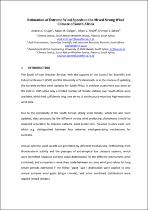 ResearchSpace
ResearchSpace
Estimation of extreme wind speeds in the mixed strong wind climate of South Africa
JavaScript is disabled for your browser. Some features of this site may not work without it.
- ResearchSpace
- →
- Research Publications/Outputs
- →
- Conference Publications
- →
- View Item
| dc.contributor.author |
Kruger, AC

|
|
| dc.contributor.author |
Goliger, Adam M

|
|
| dc.contributor.author |
Retief, JV

|
|
| dc.contributor.author |
Sekele, SS

|
|
| dc.date.accessioned | 2010-09-28T09:02:18Z | |
| dc.date.available | 2010-09-28T09:02:18Z | |
| dc.date.issued | 2010-08 | |
| dc.identifier.citation | Kruger, AC, Goliger, AM, Retief, JV and Sekele, S. 2010. Estimation of extreme wind speeds in the mixed strong wind climate of South Africa. Proceedings of the 14th Australasian Wind Engineering Society (AWES) Workshop, Canberra, Australia, 5-6 August 2010, pp 5 | en |
| dc.identifier.uri | http://hdl.handle.net/10204/4371 | |
| dc.description | 14th Australasian Wind Enginering Society (AWES) Workshop, August 2010 | en |
| dc.description.abstract | The South African Weather Service, with the support of the Council for Scientific and Industrial Research (CSIR) and the University of Stellenbosch, is in the process of updating the extreme surface wind statistics for South Africa. A previous assessment was done by the CSIR in 1985 when only a limited number of climate stations over South Africa were available, which had sufficiently long time series of continuously recorded high-resolution wind data. Due to the complexity of the South African strong wind climate, which has also been updated, data produced by the different strong wind producing phenomena should be analyzed separately to improve extreme wind predictions. Previous studies exist, one which e.g. distinguished between four extreme wind-generating mechanisms for Australia. Annual extreme wind speeds are generated by different mechanisms, forthcoming from thunderstorm activity and the passages of extratropical low pressure systems, which were identified. Separate extreme value distributions for the different mechanisms were combined, and comparisons were then made between extreme wind gust values for long return periods estimated if the Fisher-Tippet Type I distribution were applied to only annual extreme wind gusts (single climate), and when combined distributions were applied (mixed climate). For longer return periods the differences between the extreme wind speeds estimated from single and combined distributions become larger. This result is especially important in the design processes of structures with special importance e.g. power supply utilities, where extreme wind speed values for very long return periods are often required | en |
| dc.language.iso | en | en |
| dc.subject | Extreme wind speeds | en |
| dc.subject | Mixed strong winds | en |
| dc.subject | Climate | en |
| dc.subject | Wind engineering society | en |
| dc.title | Estimation of extreme wind speeds in the mixed strong wind climate of South Africa | en |
| dc.type | Conference Presentation | en |
| dc.identifier.apacitation | Kruger, A., Goliger, A. M., Retief, J., & Sekele, S. (2010). Estimation of extreme wind speeds in the mixed strong wind climate of South Africa. http://hdl.handle.net/10204/4371 | en_ZA |
| dc.identifier.chicagocitation | Kruger, AC, Adam M Goliger, JV Retief, and SS Sekele. "Estimation of extreme wind speeds in the mixed strong wind climate of South Africa." (2010): http://hdl.handle.net/10204/4371 | en_ZA |
| dc.identifier.vancouvercitation | Kruger A, Goliger AM, Retief J, Sekele S, Estimation of extreme wind speeds in the mixed strong wind climate of South Africa; 2010. http://hdl.handle.net/10204/4371 . | en_ZA |
| dc.identifier.ris | TY - Conference Presentation AU - Kruger, AC AU - Goliger, Adam M AU - Retief, JV AU - Sekele, SS AB - The South African Weather Service, with the support of the Council for Scientific and Industrial Research (CSIR) and the University of Stellenbosch, is in the process of updating the extreme surface wind statistics for South Africa. A previous assessment was done by the CSIR in 1985 when only a limited number of climate stations over South Africa were available, which had sufficiently long time series of continuously recorded high-resolution wind data. Due to the complexity of the South African strong wind climate, which has also been updated, data produced by the different strong wind producing phenomena should be analyzed separately to improve extreme wind predictions. Previous studies exist, one which e.g. distinguished between four extreme wind-generating mechanisms for Australia. Annual extreme wind speeds are generated by different mechanisms, forthcoming from thunderstorm activity and the passages of extratropical low pressure systems, which were identified. Separate extreme value distributions for the different mechanisms were combined, and comparisons were then made between extreme wind gust values for long return periods estimated if the Fisher-Tippet Type I distribution were applied to only annual extreme wind gusts (single climate), and when combined distributions were applied (mixed climate). For longer return periods the differences between the extreme wind speeds estimated from single and combined distributions become larger. This result is especially important in the design processes of structures with special importance e.g. power supply utilities, where extreme wind speed values for very long return periods are often required DA - 2010-08 DB - ResearchSpace DP - CSIR KW - Extreme wind speeds KW - Mixed strong winds KW - Climate KW - Wind engineering society LK - https://researchspace.csir.co.za PY - 2010 T1 - Estimation of extreme wind speeds in the mixed strong wind climate of South Africa TI - Estimation of extreme wind speeds in the mixed strong wind climate of South Africa UR - http://hdl.handle.net/10204/4371 ER - | en_ZA |





